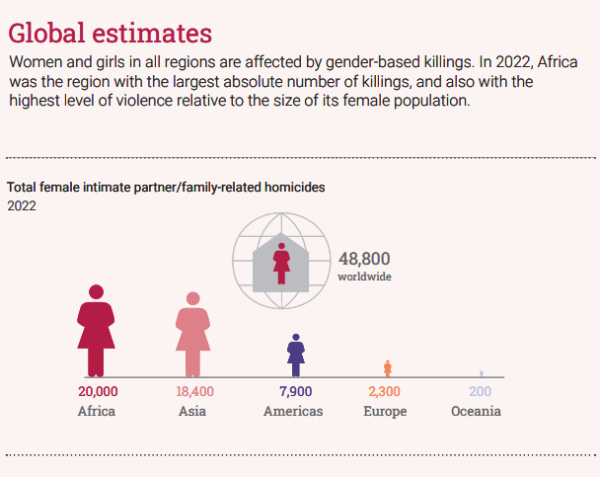In Oregon on Sept. 6, Melissa Jubane’s body was found after she was reported missing two days before. She was a nurse at Providence St. Vincent Medical Center and had been married for less than two weeks. Her neighbor Bryce Johnathan Schubert was charged with first-degree kidnapping, second-degree abuse of a corpse and second-degree murder of Jubane. Schubert pleaded not guilty. Her murder is still an ongoing investigation.
Aug. 25, in Ottawa, Canada, Jennifer Zabarylo, a 47-year-old woman was found dead in her home. Her husband was charged with second-degree murder and the Ottawa Police Service (OPS) labeled her death as a “femicide” — this was the first time the OPS ever used the term.
In Kenya, Sept. 5, Rebecca Cheptegei, a Ugandan Olympic long-distance runner, died after her ex-partner set her ablaze, adding to the femicide epidemic in the country.
“Femicide” is a term used for “the killing of females because of their gender.” It is the most extreme manifestation of violence against women and girls, rooted in patriarchal culture, misogyny and domestic violence. It was used in the feminist movements of the 1970s, where women aimed for resistance against gender violence and oppression.
Feminist author and activist, Diana E. H. Russell publicized the term when she redefined it in 1976 at the International Tribunal on Crimes Against Women, stating, “I chose the new term femicide to refer to the killing of females by males because they are females.” She chose this definition to highlight unequal gender relations and notions of male dominance across the globe. Russell explained that femicides are fatal hate crimes driven by sexism, and advocated the use of the term.
Russell further defined femicide to include intimate partner femicide, lesbicide (homophobic femicide or the murder of lesbians), racial femicide, serial femicide (sexually sadistic killing of women), female infanticide and honor killings. In 2011, Russell gave a speech called the “Origin of Femicide” explaining that femicide includes a wide variety of abuse such as rape, torture, sexual abuse, genital mutilation, unnecessary gynecological operations and the criminalization of contraceptives and abortion (leading to forced motherhood). “Whenever these forms of terrorism result in death, they become femicides,” Russell stated.
“Intimate partner femicide” is the most common type reported, in which a woman is killed by a current or former intimate partner, like in the cases of Zabarylo and Cheptegei. In 2022, only 89,000 femicide cases were recorded, and although the violence can be from anyone, over 5 percent were by an intimate partner, according to UN Women.
Additionally, according to the World Health Organization (WHO), “most cases of femicide are committed by partners or ex-partners, and involve ongoing abuse in the home, threats or intimidation, sexual violence or situations where women have less power or fewer resources than their partner.” There is a heightened risk of violence if a woman is pregnant, estranged or attempting to leave a relationship and if the perpetrator has gun ownership or has suffered from physical abuse in the past.
Femicide is a global issue, affecting women and girls everywhere. Unfortunately, the majority of femicides that happen occur in countries where collecting and reporting data is difficult because of the normalization of women not being valued. Due to this, most cases of femicide are in reality much higher than the actual recorded statistics. The United Nations Office on Drugs and Crime published a document on femicide and made a report showing “four in ten female homicides globally remain unclassified.”
The published document also stated, “that in 2021, around 45,000 women and girls worldwide were killed by intimate partners or other family members. This means that more than five women and girls are killed every hour by someone in their own family.” By 2022, the number of reported intimate partner femicide cases had drastically increased to an estimated 48,800 worldwide, keeping in mind that thousands of cases still go unreported.

Countries like Kenya are facing the worst femicide cases ever, according to the WHO in 2020, an estimated 47 women were killed each week in Kenya. The high percentage of femicides is likely a direct reflection of inequalities in gender norms and a normalization of violence. Gender norms are deeply rooted in many cultures making women submit to the patriarchal power imbalances. Young girls in Kenya are forced to undergo genital mutilation, child marriages and live in abusive households, all of which can end in death.
Over the past eight years, 75 percent of female homicide victims were killed by intimate partners, according to data by the African Data Hub. In Jan. 2024, it was estimated that at least 14 women alone were killed within that month. On Jan. 27, Kenyan women took to the streets for city-wide protests held against gender-based violence, the protests also took to storm on social media with the hashtags #EndFemicideKE and #StopKillingUs.
In Asia and the Middle East, women are killed in the name of “honor.” This means a woman is killed by her family because of an assumed or actual, sexual or behavioral transgression, such as sexual intercourse, adultery, or even being raped. According to UN Women Asia and the Pacific, 18,100 of the 45,000 intimate partner femicide cases reported in 2021 were located in the Asia-Pacific region.

Femicide is not just an issue in third-world nations. First-world nations, like the United States, have also reported cases and have more recent data on femicides. According to Sanctuary for Families, as of March 2023, 70 percent of femicides that occur in high-income countries are in the United States — that’s 2.6 killings per 100,000 women.
In the U.S., almost three women every day are also killed by an intimate partner, most of these killings involve them getting beaten, stabbed or strangled. Women and girls of color in the U.S. are at an even higher risk; Black women are murdered at a rate three times higher than white women and the homicide rate for Indigenous women is six times higher.
Femicide Census is a unique database that serves as a source of information about women killed by men in the UK. According to their 2021 Femicide Census Report, “at least 147 women were killed by 144 men in 2021,” of those 147 women, 78 (53 percent) were killed by a current or former intimate partner. The report breaks down further statistical information on the women killed, the perpetrators and the criminal justice outcomes.
Latin America also has some of the highest femicide rates, especially in Central American countries like Honduras and El Salvador. However, in recent years, 16 countries in Latin America, including Mexico, El Salvador and Colombia have passed legislative laws to criminalize femicide and give perpetrators longer conviction times.
Alongside criminalizing femicide, women in Latin America have also created social media movements to spread their voices globally. #NiUnaMenos (Not One Less) is a famous social movement that was spread in Latin America after Chiara Páez, a pregnant 14-year-old, was beaten to death by her 16-year-old boyfriend in Argentina in 2015. #NiUnaMenos was created in protest, meaning not to lose one more woman to violence.
The criminalization of femicide has often been argued against. In 2021, the UK parliament rejected a petition to make femicide a crime, stating: “We’re not sure exactly what you’d like the Government or Parliament to do. Murder is already a crime, so we’re not sure what you’d like to happen by creating a new offense.” Many argue that since murder is already a crime, there is no use in making a separate category for women and girls who are murdered.
However, in 2020, Ivana Milovanović, a Serbian court judge, stated to UN Women that femicide should be a specific criminal offense. “Femicide differs from other forms of murder because it is the gender-related killing of a woman only because she is a woman. This indicates that the root causes of femicide differ from other types of murder and are related to the general position of women in the society, discrimination against women, gender roles, unequal distribution of power between men and women, habitual gender stereotypes, prejudices and violence against women,” said Milovanović.
There is a misogynistic and patriarchal nature to femicide that leads to the lack of protection for women and girls globally. When recognizing femicide as a crime, more data can be collected on this horrific act leading to more measures to ensure the safety of women and girls so abuse and femicide don’t happen in the first place.
Even with femicide becoming a legalized crime in a few countries, the violence has not ended and thousands of cases continue to go unreported and undocumented adding to the horror of the lack of protection women and girls suffer worldwide, every day and every hour.










Iman Ahmad • Sep 27, 2024 at 7:33 pm
what an important topic and enlightening piece of work!